CHAPTER 61
Homemade Casting Materials
Plaster bandages
Although commercial plaster bandages work best, they are very expensive. You can make homemade plaster bandages for as little as one tenth the cost. Or some of the disabled children can learn to make them. You will need:
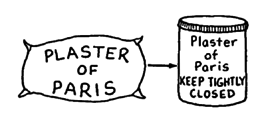
| plaster of Paris. If possible, a high-quality type such as dental plaster of Paris. Keep it in a tightly closed moisture-proof container. |

| gauze cloth or crinoline. Crinoline, which is a high-quality open mesh cloth, works best. Good quality gauze can also be used. Holes should be about 8 to 10 per cm. (20 per inch). Cheesecloth also works, but not as well. |
HOW TO PREPARE:
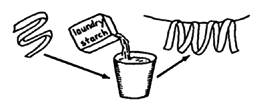
| If you use gauze or cheesecloth, first dip it into a weak solution of laundry starch and let it dry. This helps the bandage keep its shape. |

| Cut the cloth into strips of the width you want. |

| Rub plaster powder into the cloth and roll or fold it loosely. Do not roll it tightly or the inner part will not get wet when dipped for use. |
The most common problem is that the gauze does not hold enough of the plaster powder. Even if you put on a lot, some powder always falls out. The test is when you apply the wet bandage. As you rub each layer into the next, the threads of cloth should disappear into the smooth, wet, plaster surface. If not, there is not enough plaster and it will not set hard.

Suggestion: Have some dry plaster powder ready when you are casting. If needed, sprinkle a little powder over each layer of bandage and rub it smooth with wet hands. Add more to the final layer and rub it in to form a polished surface.
Storage: Wrap the plaster bandages in old newspaper or plastic bags and store in an airtight container. Do not prepare too many at a time. They can absorb moisture and spoil.
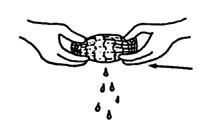
CAUTION: When wetting for use, up to a third of the plaster may be lost in the water. To reduce loss, put bandage gently into water and then let it drip. If you squeeze it, hold the ends of the roll and gently squeeze toward the center.
Homemade plaster takes longer to get hard than commercial 'fast-setting' plaster. To speed up hardening, heat the water or add a little salt to it.
Casts made of wax
To prepare a mold of a leg for making plastic braces, the first (hollow) cast can be made of wax instead of plaster. Use either candle wax (paraffin) or beeswax. Wax can be much cheaper than plaster bandage, especially it the wax is re-used. To make a wax cast:
1. Melt the wax in a can placed in hot water.

2. Cut several strips of soft absorbent cloth.

3. Soak the cloth in hot wax.

4. When it has cooled enough not to burn, wrap the waxed cloths around the foot.
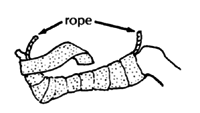
5. While the wax is still warm and soft, rub and press it against the leg.
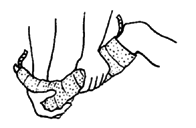
6. Hold the foot in the desired position until the wax hardens. (To speed hardening, you can put the foot in cold water.)

7. Cut the wet cast along the rope, and carefully remove it. Go on with the other steps as described on Page 552.
| Note: Before putting on the wax, you can cover the foot with 'stockinette'. Also, place a rope or strip of plastic along the top of the leg to make cutting the cast easier. (See Page 552.) |
Re-using the wax: After the positive plaster mold has been made from the wax cast, the wax can be re- used. Heat up the pieces of waxed cloth and use them to form a new cast. Or boil the waxed cloth in water, holding the cloth under the surface with rocks or metal. The hot wax will rise to the surface. When it cools, lift it off and re-use it.
OTHER POSSIBLE MATERIALS FOR CASTING OR MOLDING
Many materials can be used for casts. Most have the disadvantage that they take a long time to harden. Possibilities include:
- Papier máché (see Page 471). Very slow hardening. Careful use of a heat lamp or 'hair dryer' speeds drying.
- Traditional cast materials. For example:
· In Mexico, the juices of certain plants, boiled into a thick syrup and soaked into a cloth, will harden into a cast (see Where There Is No Doctor, Page 14).
· In India, traditional bone setters make casts using cloth covered with egg white mixed with flour.
- Flour made from cassava (manioc) is also used in India to make casts.
To make the solid (positive) mold of a limb (see Page 552), 'building plaster' works well. (Wax cannot be used because it melts when hot plastic is placed over it.) Clay also works, but takes several days to dry.


